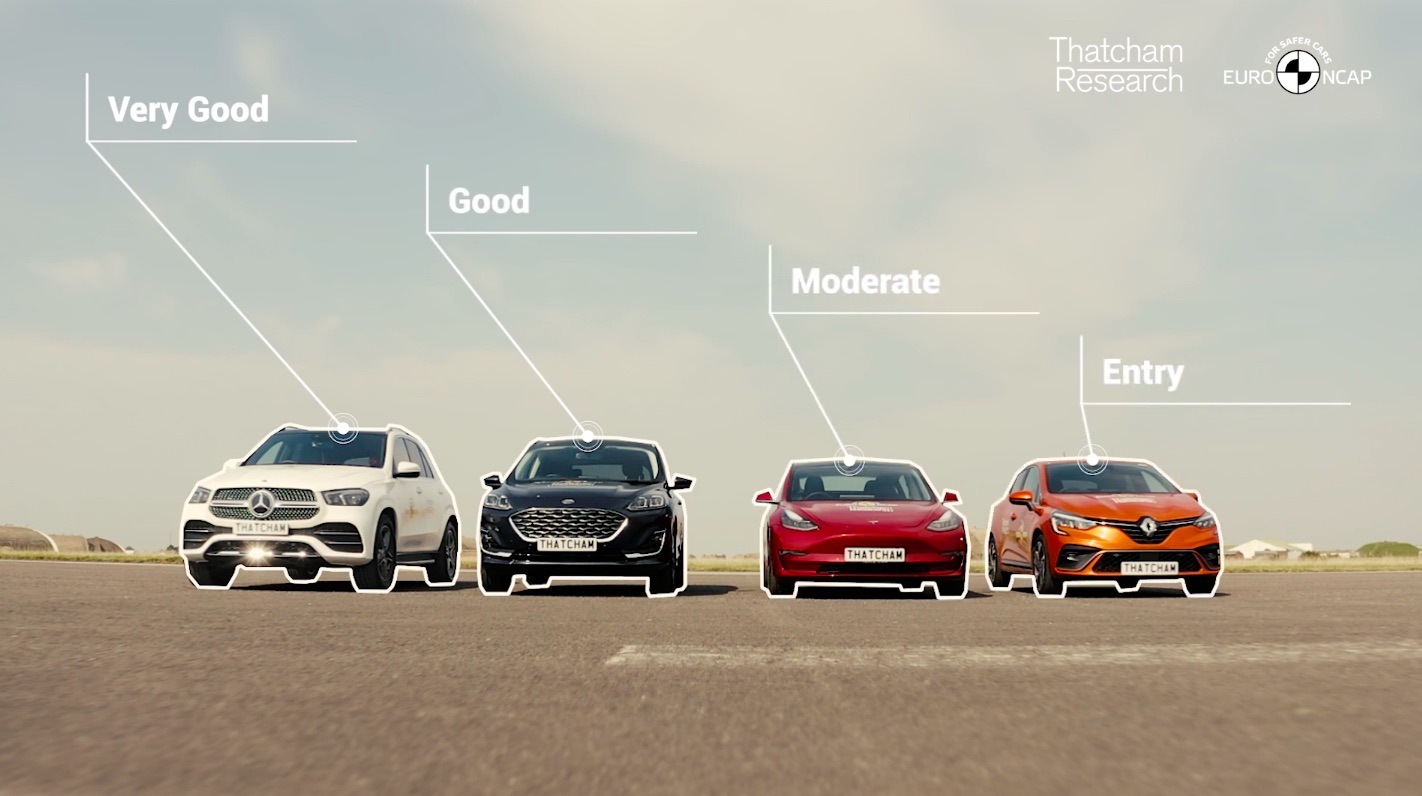
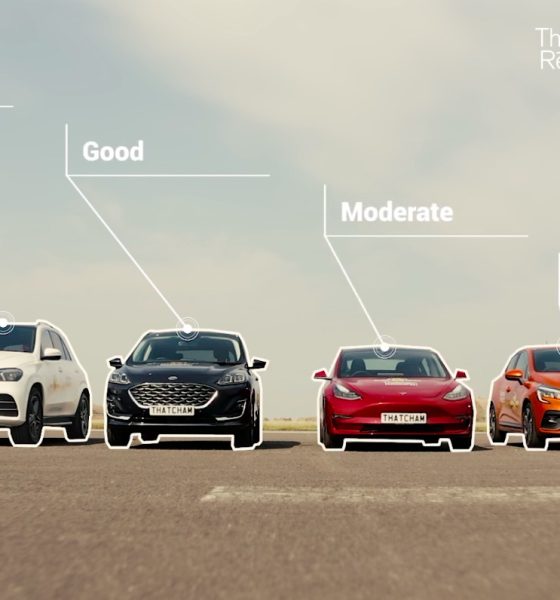
News
Tesla Model 3 gets penalized in Europe despite top scores in vehicle assistance and safety
In collaboration with Thatcham Research, the Euro NCAP has launched the world’s first Assisted Driving Grading system, a new set of metrics that are specifically designed to evaluate the driver-assist systems of cars available on the market today. For its first batch of vehicles, the firms evaluated 10 cars, from premium SUVs like the Mercedes-Benz GLE to affordable hatchbacks like the Renault Clio to all-electric vehicles like the Tesla Model 3.
As noted by Thatcham Research Director of Insurance Research Matthew Avery in a video outlining the results of the Assisted Driving Grading system’s first tests, vehicles would be graded on three metrics: the level of vehicle assistance that they provide, the level of driver engagement that they offer, and the effectiveness of their safety backup systems. The results of these tests, especially on the Tesla Model 3’s part, were rather peculiar, to say the least.
Out of 10 vehicles that were evaluated, the Tesla Model 3 ranked 6th with a “Moderate” grade, falling behind the Mercedes-Benz GLE, BMW 3-Series, and Audi Q8, which were graded as “Very Good,” and the Ford Kuga, which received a “Good” rating. This was despite the Tesla Model 3 receiving the top scores in the “Vehicle Assistance” and “Safety Backup” metrics.
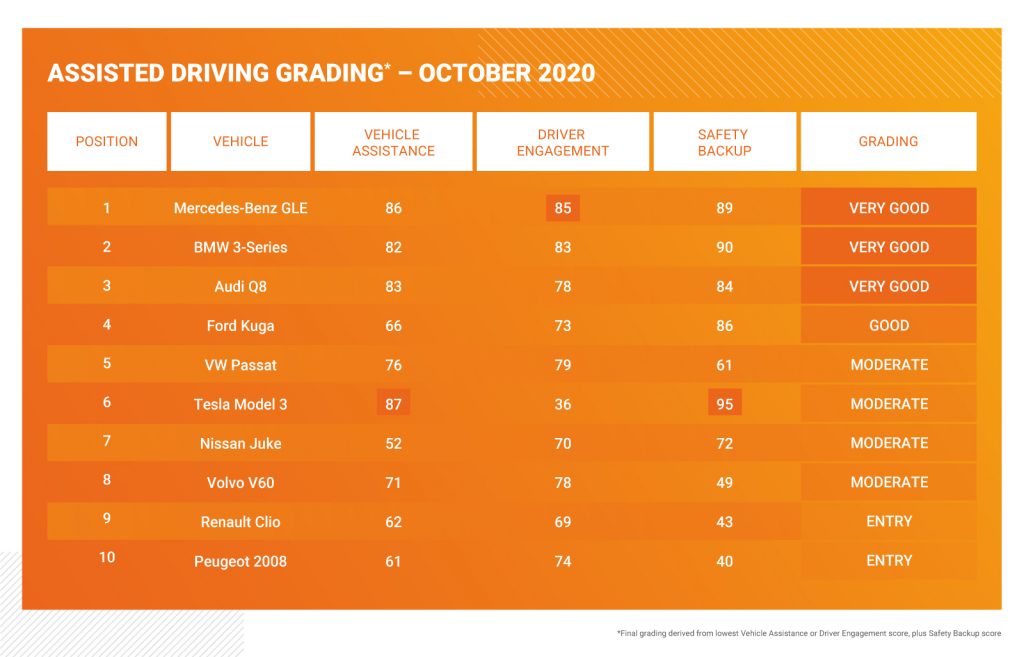
The study, for example, dubbed the Model 3 as outstanding in terms of steering assistance, with the vehicle steering itself exceptionally well through an S-shaped curve at speeds of 80, 100, and 120 km/h. Tesla’s lane change systems were also satisfactory, despite the system’s limitations in Europe. Distance control was dominated by the Model 3 as well, with the evaluators stating that Tesla’s adaptive cruise control featured a “high level of technical maturity.” From a score of 100, Tesla’s vehicle assistance received a score of 87, the highest among the cars tested.
The Model 3’s safety backup systems were also a league above its competition. As noted in a post from the Allgemeiner Deutscher Automobil-Club e.V. (ADAC), Tesla demonstrated its strengths with the Model 3’s collision avoidance systems. The all-electric sedan earned a perfect score in the firms’ tests, outperforming its premium German competition. Overall, the Model 3 received an impressive score of 95 in the Assisted Driving Grading system’s “Safety Backup” metric.
Considering these scores, one might wonder why the Model 3 ended up ranked 6th among the 10 vehicles tested by the Euro NCAP and Thatcham Research. As it turned out, this was because of the Model 3’s poor scores in the “Driver Engagement” metric, where the vehicle only earned a score of 35 out of 100. So poor was the Model 3’s scores in this metric that it was ranked last among the 10 vehicles that were evaluated.
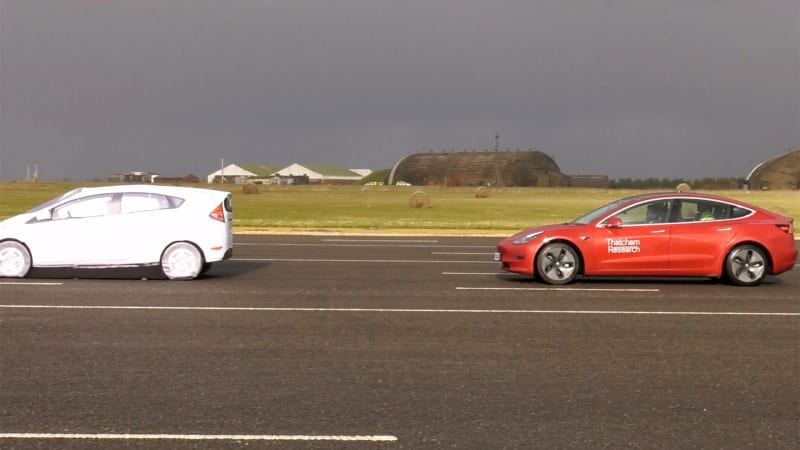
A look at the reasons behind the Model 3’s poor scores in “Driver Engagement” includes a number of interesting insights from Thatcham Research and the Euro NCAP. When testing the vehicles’ steering override functions, for example, the evaluators stated that the Model 3 resisted steering overrides from its driver. These issues were explained in the ADAC’s post.
“Should the driver make a steering movement in order to avoid an object or a pothole in the roadway, the steering assistant should allow this without resistance. In the Tesla Model 3, for example, this is not the case. Apparently, Tesla trusts the system more than its driver. The necessary cooperative assistance is not given. Instead, the Tesla system prevents its driver from attempting to intervene – it mustn’t be,” the ADAC remarked in its post.
Even more interesting is that part of the Model 3’s poor “Driver Engagement” scores was due to the term “Autopilot,” which Tesla uses to describe its driver-assist suite. The evaluators argued that the term “Autopilot” was misleading and irresponsible on Tesla’s part, and this was heavily taken against the Model 3’s rankings in the Assisted Driving Grading system.
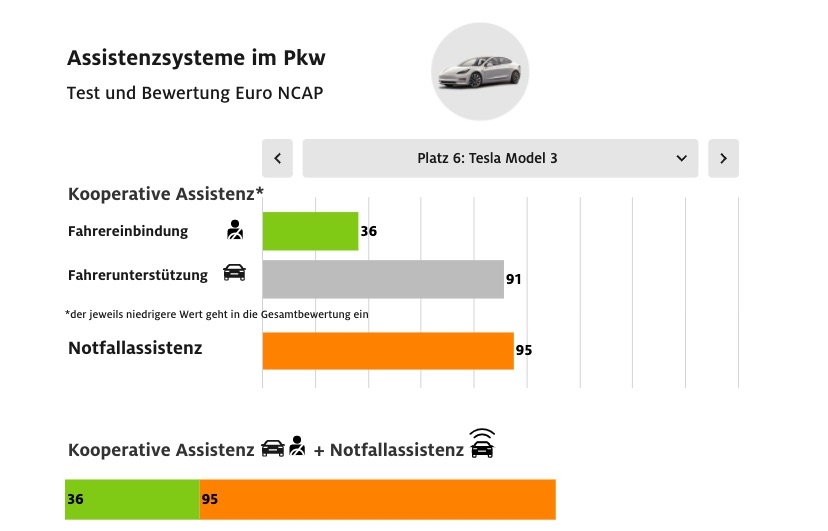
“When it comes to the first test criterion – consumer information – the Tesla Model 3 in particular fails. The assistance systems are referred to as “Autopilot” in the operating instructions for the Model 3 as well as in the sales brochures and in marketing. However, the term suggests capabilities that the system does not have in sufficient measure. It tempts the driver to rely on the capabilities of the system – which is currently not allowed by the legislature anyway. Due to its good quick-start operating aid, the Tesla Model 3 still receives 10 points,” the evaluators noted.
Ultimately, these complaints about Autopilot’s branding ended up pulling down the Model 3’s scores to the point where the all-electric sedan was ranked below the Ford Kuga. Thatcham Research Director of Insurance Research Matthew Avery explained this in a video released about the evaluation. “The Tesla Model 3 was the best for safety backup and vehicle assistance but lost ground for misleading consumers about the capability of its Autopilot system and actively discouraging drivers from engaging when behind the wheel,” Avery said.
As noted by Avery, it is pertinent for vehicles to exhibit a balance to score very well in the Assisted Driving Grading system. This was not achieved by the Model 3 despite its industry-leading backup safety systems and actual vehicle assistance tech. ADAC explained it best when outlining why the Tesla Model 3 lost to four other vehicles despite being equipped with what is noticeably the most advanced driver-assist system.
“When analyzing the test results, it is noticeable that the Tesla Model 3 has the most advanced assistance systems. With 95 points for emergency assistance (Safety Backup) and 91 points for technical assistance, it doesn’t beat the Mercedes GLE by far, but at least 11 points… Because Euro NCAP removes the many points in the area of driver support from the Tesla, because on the one hand it does not sufficiently comply with the driver’s request for a steering correction. On the other hand, because Tesla is irresponsible about the term autopilot – an even more serious reason. With only 36 points from the test area driver integration, the Tesla falls back to sixth place in the final bill,” the ADAC noted.
Thatcham Research’s overall findings could be viewed in the video below.

News
Tesla Giga Berlin draws “red line” over IG Metall union’s 35-hour week demands
Factory manager André Thierig has drawn a “red line” against reducing Giga Berlin’s workweek to 35 hours, while highlighting that Tesla has actually increased its workers’ salaries more substantially than other carmakers in the country.

Tesla Giga Berlin has found itself in a new labor dispute in Germany, where union IG Metall is pushing for adoption of a collective agreement to boost wages and implement changes, such as a 35-hour workweek.
In a comment, Giga Berlin manager André Thierig drew a “red line” against reducing Giga Berlin’s workweek to 35 hours, while highlighting that Tesla has actually increased its workers’ salaries more substantially than other carmakers in the country.
Tesla factory manager’s “red line”
Tesla Germany is expected to hold a works council election in 2026, which André Thierig considers very important. As per the Giga Berlin plant manager, Giga Berlin’s plant expansion plans might be put on hold if the election favors the union. He also spoke against some of the changes that IG Metall is seeking to implement in the factory, like a 35-hour week, as noted in an rbb24 report.
“The discussion about a 35-hour week is a red line for me. We will not cross it,” Theirig said.
“(The election) will determine whether we can continue our successful path in the future in an independent, flexible, and unbureaucratic manner. Personally, I cannot imagine that the decision-makers in the USA will continue to push ahead with the factory expansion if the election results favor IG Metall.”
Giga Berlin’s wage increase
IG Metall district manager Jan Otto told the German news agency DPA that without a collective agreement, Tesla’s wages remain significantly below levels at other German car factories. He noted the company excuses this by referencing its lowest pay grade, but added: “The two lowest pay grades are not even used in car factories.”
In response, Tesla noted that it has raised the wages of Gigafactory Berlin’s workers more than their German competitors. Thierig noted that with a collective agreement, Giga Berlin’s workers would have seen a 2% wage increase this year. But thanks to Tesla not being unionized, Gigafactory Berlin workers were able to receive a 4% increase, as noted in a CarUp report.
“There was a wage increase of 2% this year in the current collective agreement. Because we are in a different economic situation than the industry as a whole, we were able to double the wages – by 4%. Since production started, this corresponds to a wage increase of more than 25% in less than four years,” Thierig stated.
News
Tesla is seeing a lot of momentum from young Koreans in their 20s-30s: report
From January to November, young buyers purchased over 21,000 Teslas, putting it far ahead of fellow imported rivals like BMW and Mercedes-Benz.

Tesla has captured the hearts of South Korea’s 20s-30s demographic, emerging as the group’s top-selling imported car brand in 2025. From January to November, young buyers purchased over 21,000 Teslas, putting it far ahead of fellow imported rivals like BMW and Mercedes-Benz.
Industry experts cited by The Economist attributed this “Tesla frenzy” to fandom culture, where buyers prioritize the brand over traditional car attributes, similar to snapping up the latest iPhone.
Model Y dominates among young buyers
Data from the Korea Imported Automobile Association showed that Tesla sold 21,757 vehicles to the 20s-30s demographic through November, compared to BMW’s 13,666 and Mercedes-Benz’s 6,983. The Model Y led the list overwhelmingly, with variants like the standard and Long Range models topping purchases for both young men and women.
Young men bought around 16,000 Teslas, mostly Model Y (over 15,000 units), followed by Model 3. Young women followed a similar pattern, favoring Model Y (3,888 units) and Model 3 (1,083 units). The Cybertruck saw minimal sales in this group.
The Model Y’s appeal lies in its family-friendly SUV design, 400-500 km range, quick acceleration, and spacious cargo, which is ideal for commuting and leisure. The Model 3, on the other hand, serves as an accessible entry point with lower pricing, which is valuable considering the country’s EV subsidies.
The Tesla boom
Experts described Tesla’s popularity as “fandom culture,” where young buyers embrace the brand despite criticisms from skeptics. Professor Lee Ho-geun called Tesla a “typical early adopter brand,” comparing purchases to iPhones.
Professor Kim Pil-soo noted that young people view Tesla more as a gadget than a car, and they are likely drawn by marketing, subsidies, and perceived value. They also tend to overlook news of numerous recalls, which are mostly over-the-air software updates, and controversies tied to the company.
Tesla’s position as Korea’s top import for 2025 seems secured. As noted by the publication, Tesla’s December sales figures have not been reported yet, but market analysts have suggested that Tesla has all but secured the top spot among the country’s imported cars this year.
News
Tesla FSD fleet is nearing 7 billion total miles, including 2.5 billion city miles
As can be seen on Tesla’s official FSD webpage, vehicles equipped with the system have now navigated over 6.99 billion miles.

Tesla’s Full Self-Driving (Supervised) fleet is closing in on almost 7 billion total miles driven, as per data posted by the company on its official FSD webpage.
These figures hint at the massive scale of data fueling Tesla’s rapid FSD improvements, which have been quite notable as of late.
FSD mileage milestones
As can be seen on Tesla’s official FSD webpage, vehicles equipped with the system have now navigated over 6.99 billion miles. Tesla owner and avid FSD tester Whole Mars Catalog also shared a screenshot indicating that from the nearly 7 billion miles traveled by the FSD fleet, more than 2.5 billion miles were driven inside cities.
City miles are particularly valuable for complex urban scenarios like unprotected turns, pedestrian interactions, and traffic lights. This is also the difference-maker for FSD, as only complex solutions, such as Waymo’s self-driving taxis, operate similarly on inner-city streets. And even then, incidents such as the San Francisco blackouts have proven challenging for sensor-rich vehicles like Waymos.
Tesla’s data edge
Tesla has a number of advantages in the autonomous vehicle sector, one of which is the size of its fleet and the number of vehicles training FSD on real-world roads. Tesla’s nearly 7 billion FSD miles then allow the company to roll out updates that make its vehicles behave like they are being driven by experienced drivers, even if they are operating on their own.
So notable are Tesla’s improvements to FSD that NVIDIA Director of Robotics Jim Fan, after experiencing FSD v14, noted that the system is the first AI that passes what he described as a “Physical Turing Test.”
“Despite knowing exactly how robot learning works, I still find it magical watching the steering wheel turn by itself. First it feels surreal, next it becomes routine. Then, like the smartphone, taking it away actively hurts. This is how humanity gets rewired and glued to god-like technologies,” Fan wrote in a post on X.








